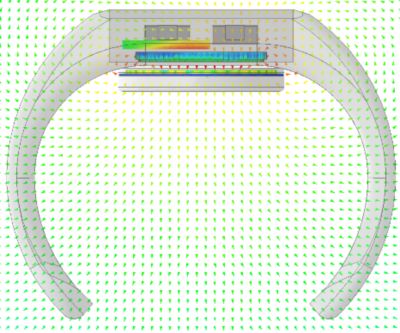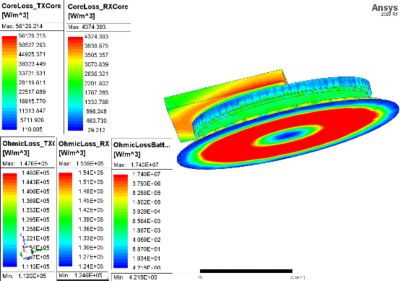-
-
学生向け無料ソフトウェアにアクセス
Ansysは次世代の技術者を支援します
学生は、世界クラスのシミュレーションソフトウェアに無料でアクセスできます。
-
今すぐAnsysに接続!
未来をデザインする
Ansysに接続して、シミュレーションが次のブレークスルーにどのように貢献できるかを確認してください。
国および地域
無料トライアル
製品およびサービス
リソースとトレーニング
当社について
Back
製品およびサービス
Ansysブログ
February 16, 2024
ワイヤレス充電における熱マネジメント: 課題とソリューション
ワイヤレス充電器は、直接的な接触なしに電磁界誘導による電気エネルギーの伝達を可能にすることで、煩雑なケーブルやコードを使わずにスマートフォン、時計、タブレット、イヤホンなどに電力を供給できます。電子機器のより高速な充電に対する要求が高まる中、特に電子機器が小型化され、携帯性が向上するにつれて、過熱の問題を防ぐために熱マネジメントが重要になります。
ワイヤレス充電器が過熱する原因
ワイヤレス充電器は、電磁界誘導を用いて、充電器内の送電コイルからデバイス内の受電コイルにエネルギーを伝達します。充電中にデバイスと充電器を触ると、どちらも温度が上昇していることがわかります。これは、充電器コンポーネントの電磁界損失によって電力損失が生じ、それによって熱が生じるためです。


Ansys Maxwellでのワイヤレス充電スマートウォッチの磁束強度ベクトルと全体的な損失分布のシミュレーション
ワイヤレス充電におけるエネルギー伝達
電気エネルギーは、デバイスの送電コイルによって磁場に変換され、受電コイルによって電気エネルギーに戻ります。
エネルギー損失を制限し、充電効率を最大化するには、送電コイルと受信コイルの適切なアラインメントが必要です。充電器と受信機の両方に内蔵されている磁石により、正しい充電位置で接続されたときに、しっかりと固定された感覚を得られます。
ワイヤレス充電器における熱に関する問題
ワイヤレス充電器には、コイルのアラインメントに加えて、ユーザーの安全とデバイスの性能を確保するために対処する必要がある固有の熱の問題があります。
コンパクトな設計: 筐体が小さいと、熱冷却システムを充電器に統合するための選択肢が限定されます。
標準準拠: 充電器の機能を安全な動作限界(皮膚痛覚しきい値では44℃未満)内に収めるには、規制要件を満たす必要があります。
可変条件: 荷重や周囲温度などのリアルタイムの変化に対応するためには、ワイヤレス充電器の適応性が必要です。
効果的な熱マネジメント戦略の特定
ワイヤレス充電器の熱マネジメントにおける主な課題は、他の電子機器に見られるものと似ています。つまり、充電の高速化とデバイスの小型化に対する需要です。消費者は、ポケットにも収まる高速で便利な充電ソリューションを求めています。しかし、スマートウォッチやその他の消費者向け小型エレクトロニクスデバイスの全体的なフットプリントを小さく維持するために、ファンのようなかさばる冷却ソリューションを追加することは適切ではないでしょう。エンジニアは、以下に示すような代替の冷却方法を検討することで、小さなスペースに収まるソリューションを設計する際に安全な熱しきい値を遵守しています。
材料の選択: スマートウォッチのケースのように、樹脂材料よりも熱伝導率が高いシリコンベースの材料を選択して、熱放散を改善します。
コンポーネントの配置: パラメトリックスイープ解析を使用して、コンポーネントの位置と寸法を最適化し、発熱するコンポーネントの集中を避けます。
換気: コンポーネントの周囲に自然気流または強制気流を取り入れることで、熱放散と熱冷却を促します。
断熱: 隣接領域への熱伝達を最小限に抑える材料で、発熱コンポーネントを囲みます。
ヒートシンク: サーマルフィンを介して熱源から熱を引き抜くために、熱の経路を設計し、表面積を増やします。
システム効率の解析: ワイヤレス充電器の磁気、熱、パワーエレクトロニクスの側面を検討することで、システム性能を評価し、消費者がより高速な充電を行えるようにします。
設計者が材料の選択、コンポーネントの配置、筐体のタイプなど、さまざまな熱マネジメントオプションを検討する際に、より多くの選択肢が与えられます。ワイヤレス充電器の設計にシミュレーションを使用することで、電子機器の設計者はプロトタイプを作成する前に熱マネジメント戦略を検証し、設計を最適化することができます。設計者は、Ansys Maxwell、Ansys Icepak、Ansys Grantaなどのシミュレーションソフトウェアを使用することで、それぞれの選択肢がさまざまな性能シナリオにおいてどの程度目標を達成するのかを確認できます。
ワイヤレス充電器の熱マネジメントの未来
熱マネジメントを通じて、デバイス充電時の温度上昇を抑えることで、電子機器の安全性と寿命を維持しながら、高速で効率的なエネルギー伝達を保証できます。以下のような新しい熱冷却技術は、常時接続可能な状態をさらに促し、ワイヤレス充電を、より高速で便利にします。
連続充電: オーバーザワイヤ方式充電器の範囲内にあるときはいつでも、電波を用いてデバイスを充電します。
内蔵充電器: 公共交通機関や家具など、日常生活のあらゆる要素にワイヤレス充電が内蔵されます。
ユニバーサル規格: デバイスのタイプやメーカーを問わず、ユーザーがシームレスに充電できるようにすることで、世界規模での互換性を実現します。
詳細については、オンデマンドウェビナー「ワイヤレス充電器の効率と熱性能を最適化する技術」をご覧ください。